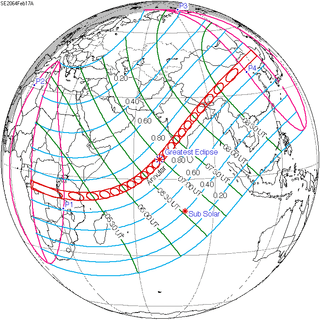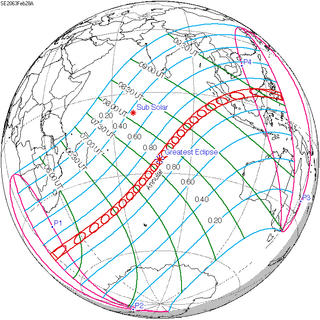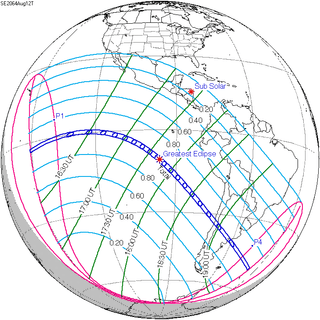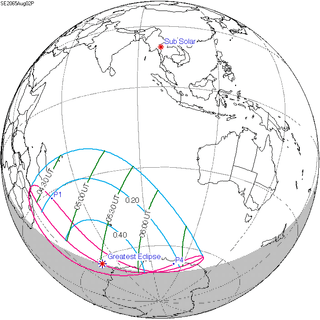Solar eclipse of February 17, 2064
| Solar eclipse of February 17, 2064 | |
|---|---|
 Map | |
| Type of eclipse | |
| Nature | Annular |
| Gamma | 0.3597 |
| Magnitude | 0.9262 |
| Maximum eclipse | |
| Duration | 536 sec (8 m 56 s) |
| Coordinates | 7°00′N 69°42′E / 7°N 69.7°E |
| Max. width of band | 295 km (183 mi) |
| Times (UTC) | |
| Greatest eclipse | 7:00:23 |
| References | |
| Saros | 141 (26 of 70) |
| Catalog # (SE5000) | 9650 |
An annular solar eclipse will occur on February 17, 2064. A solar eclipse occurs when the Moon passes between Earth and the Sun, thereby totally or partly obscuring the image of the Sun for a viewer on Earth. An annular solar eclipse occurs when the Moon's apparent diameter is smaller than the Sun's, blocking most of the Sun's light and causing the Sun to look like an annulus (ring). An annular eclipse appears as a partial eclipse over a region of the Earth thousands of kilometres wide.
Related eclipses
Solar eclipses 2062-2065
Each member in a semester series of solar eclipses repeats approximately every 177 days and 4 hours (a semester) at alternating nodes of the Moon's orbit.
| 121 | March 11, 2062 Partial |
126 | September 3, 2062 Partial |
| 131 | February 28, 2063 Annular |
136 | August 24, 2063 Total |
| 141 | February 17, 2064 Annular |
146 | August 12, 2064 Total |
| 151 | February 5, 2065 Partial |
156 | August 2, 2065 Partial |
References
| Wikimedia Commons has media related to Solar eclipse of February 17, 2064. |

